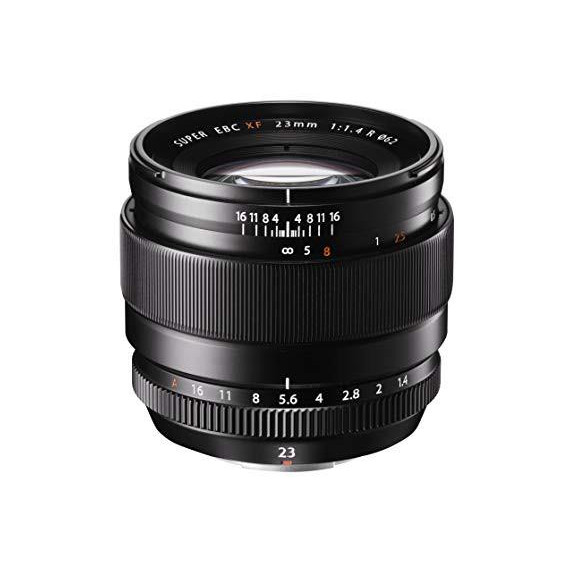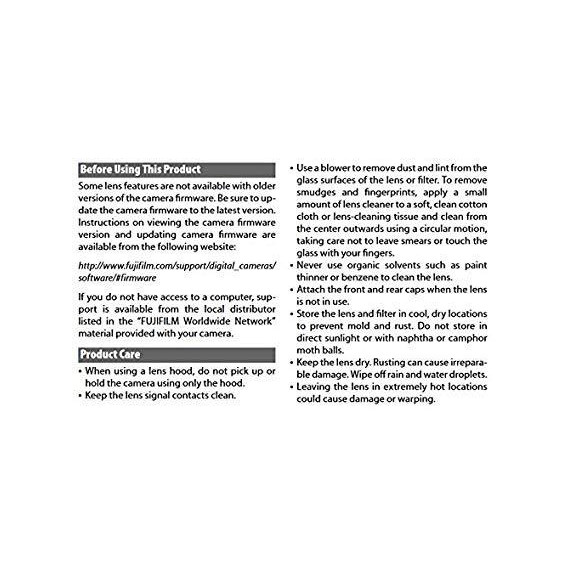Ray
There is not much more that I can say about this lens than has already been said. The Fuji XF 23mm is simply one of Fujis superb offerings for the X-mount system, and it offers what only this type of lens can: a huge aperture and a moderately wide angle of view. Although most major lens manufacturers offer a lens of this type in their respective line-ups, these are typically large, heavy, and, of course, expensive. They often can yield excellent performance, because, to be perfectly frank about it, if a lens manufacturer (say, Nikon, or Canon, or even Zeiss or Leica) is going to make this type of "specialist" lens, purchasers will demand performance matching the cost. What makes this particular lens unique is that it offers this wide-angle/large aperture specification for the mirrorless Fuji X-mount system. This means that, in spite of its huge aperture (and its relatively high cost), the size and weight of the lens are nowhere near those made for APS-C or full-frame cameras, while nevertheless offering similar performance. Some will argue, not unconvincingly, that this Fuji XF model may actually outperform equivalent lenses for other platforms. Since the entire Fuji "XF" line of lenses has earned consistently strong reviews over time, this comes as really no surprise. My own experience with the XF 14mm, XF 35mm, the XF 55-200mm, and the XF 27mm Fuji lenses have certainly been the same: these are remarkable lenses that can yield superb photos, and I continue to marvel at just how good some of the results can be. I can also chime in with the chorus concerning the XF 23mm, which, although Ive only been using this past week, can confirm that the consensus view is correct. This is an impressive lens by nearly any standard. Most people identify a "trio" of Fuji lenses that are equally superb with little disagreement: the XF 56mm, the XF 90mm, and this XF 23mm. First, construction. This lens, just like most of the Fuji XF lenses, is nearly all metal and glass, and is, amazingly, made in Japan. And it shows immediately upon picking it up. The lens is solidly built, beautifully crafted, and strikes one as being even more expensive than it is. Without getting into a tussle over it, I can say that its mechanical construction and appearance easily rivals much more expensive lenses, and it would just as easily wear a "Leica" or "Zeiss" branding without any embarrassment. The unit makes use of the clutch/ring approach also used in in the Fuji XF 14mm prime: one PULLS the ring towards the camera body to engage manual focusing, and then ROTATES the ring to select focus (distance markings are revealed when the clutch is engaged). The mechanical operation of both the ring and the clutch are excellent. An additional ring used to select aperture is also present, and is itself a bit stiffer than the admittedly too-loose ring used on the Fuji XF 14mm , while nevertheless remaining absolutely smooth. The lens presents with a nearly full-metal body, and although I am sure there are some high-quality plastics used internally, the exterior cladding has the classic XF look. In spite of the huge, F/1.4 aperture, the weight of the lens is quite good, even arguably light at 300g. For the X-mount system, this weight falls right in the middle of the spectrum (all the way from the diminutive 87g of the XF 27mm all the way to the 490g of the XF 55-200m [and 995g for the upcoming XF 50-140mm]). As many reviewers have said, it is a good weight for both the X-T1 and X-T2 cameras, providing a very good weight balance, but its not at all bad even on the X-A1/2/3 (consistently underrated cameras; this also applies to the X-M1). Ive used it on both cameras, and I would say that the physical advantage of using it on the X-T2 (and, to a lesser extent, the X-T1) is that cameras use of a much deeper, thicker hand grip, which allows you to move the camera and lens around a bit more comfortably than with the too-thin X-A1 and X-M1 bodies (but I nevertheless remain as one of those who still thinks the X-A1 is a remarkably underrated camera). As for image quality, it has all been said before. This lens, like many of its XF brethren, has nothing less than lovely image quality. Color rendition is superb, sharpness is excellent (getting sharper with a stopped down aperture, but why mess with a lens like this only to stop down the aperture?), and images have a bitingly realistic view to them. I would be tempted to use the unscientific term "clarity" or "cinematic" to describe how the images appear, and one only need to knock out a few dozen shots to see exactly what is meant by that word usage. The images that result can be highly impressive, sometimes spectacular, and with that huge aperture, not only is low-light shooting easily possible, but out-of-focus bokeh can be very well achieved. Its not a portraiture lens, but it sure wants to be. Some people report that this is their favorite Fuji lens and that the XF 23mm never comes off their camera. Besides the image quality, the field of view is a 35mm equivalent, a width that is preferred by many photographers. For me, this is a lens to use in museums and in other indoor settings, but I can just as easily use it as a street lens if I dont need something truly wide. As is, the field of view of this lens is a great one for all kinds of uses, so its use is really restricted only by the users preferences. A nice touch is that minimum focusing distance is shorter than on most of the Fuji lenses, so you can get up pretty close to your subject, if you wish to. Shortcomings? Its hard to find very many. Like all Fuji XF primes, it has no image stabilization. Also, like most lenses, it comes with no case. Additionally, if you are a Fuji photographer (you have to be, if you are considering this lens), note that this lens has a different filter size than your other Fuji lenses (in fact, nearly all Fuji lenses have a different filter size, making you invest in an entire series of filters to cover the lot of them). And, it must be said, the lens is expensive enough to factor in price as a "shortcoming," although this is arguable, since some will argue that you get more for your money on this model than you do with equivalent lenses from different manufacturers. This ever-so-slightly "niche" lens is not necessary for one to take great photos with the Fuji X-mount system. So many of the Fuji lenses are so good that, as I have reflected in other reviews, Fuji is promoting something of a renaissance in photography (even the cheapo "XC" lenses have very good optical performance, even though they are essentially all plastic in design), and so one can pick up nearly any Fuji lens with nearly any Fuji camera and get fantastic photos. But the XF 23mm occupies a special place in the lineup. It is moderately wide, is a prime, is beautifully constructed, and has that simply huge F/1.4 light-gathering aperture that can be leveraged to effect in all types of shooting settings. Its a lovely lens that can yield lovely images that are deeply colorful, punchy, and impressively sharp. Finally, note that Fuji has now released another XF 23mm lens, but with an F/2 aperture and a modernized focusing system. This new lens is smaller and lighter and takes terrific pictures. But this "classic" 23mm lens with its huge aperture holds a place of its own. I wonder if Fuji will be able to keep this act up? I can only hope so. Its truly appreciated to see a camera company that is actually moving the technology forward and producing equipment like this. Five stars for image quality, five stars for construction quality, and four stars for price (we cant have everything, can we?). Buy it on sale if you can. (Fuji runs sales about two times per year, but then you have to be poised to jump, because the lenses sell out quickly during sales.) Plusses: ++ Excellent construction of nearly all metal and glass ++ Superb image quality that distinguishes itself from many other lenses ++ Huge F/1.4 light-gathering aperture that lets you get great bokeh and also shoot in low-light situations ++ Relatively wide angle (23mm, which is a 35mm equivalent, about 63 degrees) ++ Relatively low weight (300g) for a lens with such a large aperture and all-metal construction ++ Excellent paint cladding to the body (it may be anodized aluminum) ++ Mechanical clutch/ring for manual focusing ++ Additional mechanical aperture ring which is not too loose, like on other Fuji models ++ Very acceptable minimum focusing distance (11 inches) Minuses: -- No image stabilization (some argue that image stabilization would degrade image quality somewhat) -- No case included (I know Im moaning about this, but why cant nice cases be included with expensive lenses?) -- Slightly larger diameter body than some of the other Fuji lenses (but this is because of its large aperture) -- No common filter size across Fuji lenses, meaning youll have to buy a whole set of different filter sizes -- Expensive (but the quality/price ratio may actually be better than equivalent lenses for other camera formats; buy it on sale) -- Fuji does not seal their new lenses with tape that verifies the lens has never been opened since leaving the plant -- Fuji does have some issues with their lens caps, which tend to pop off too easily







